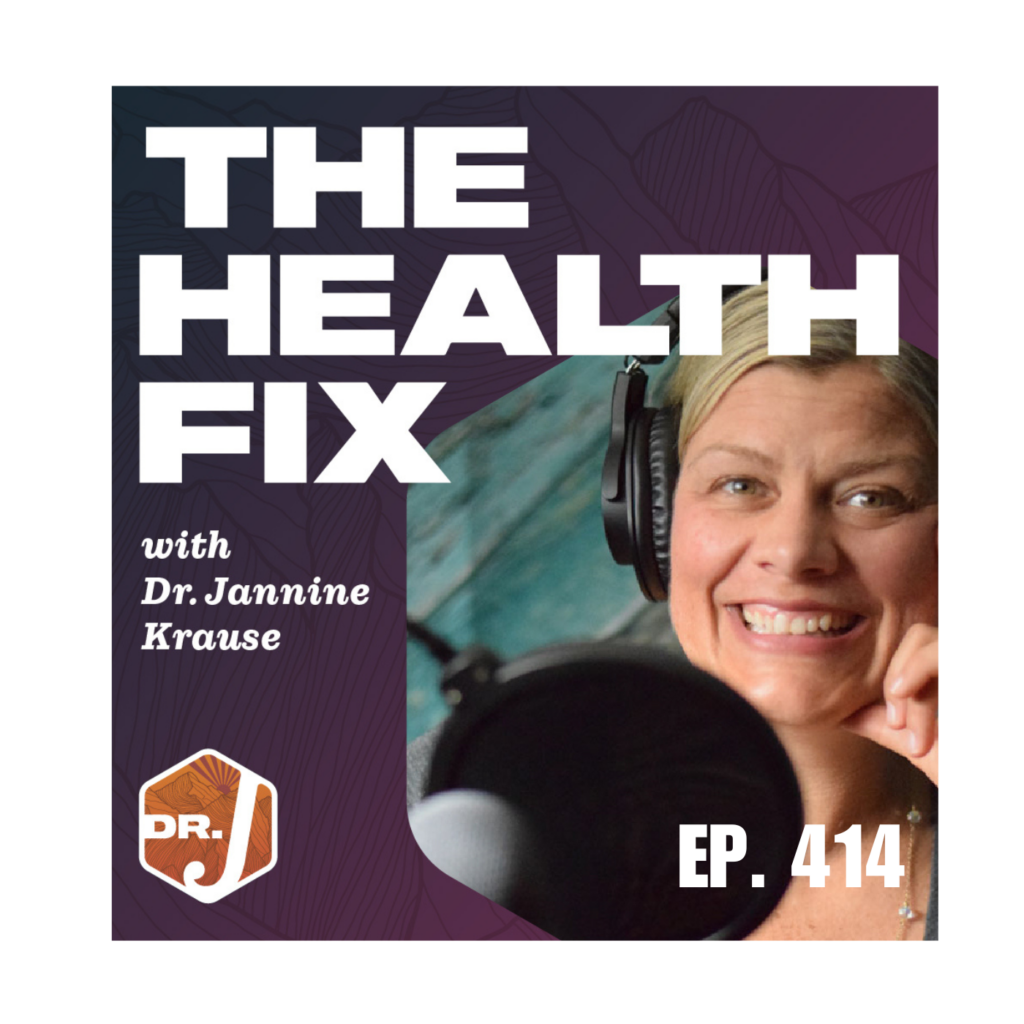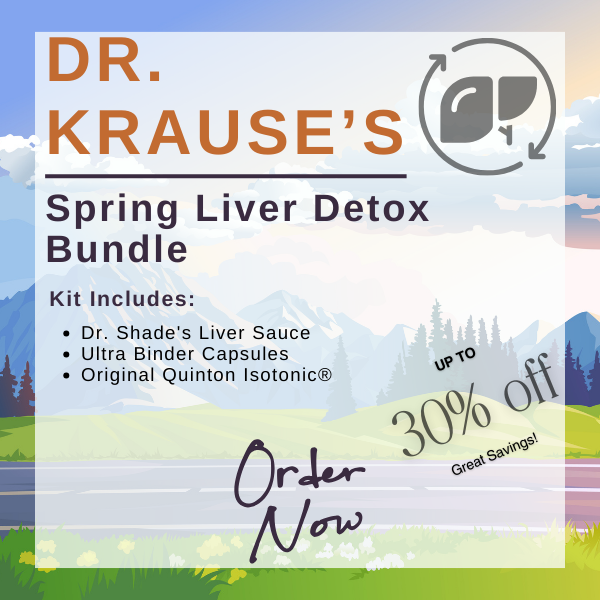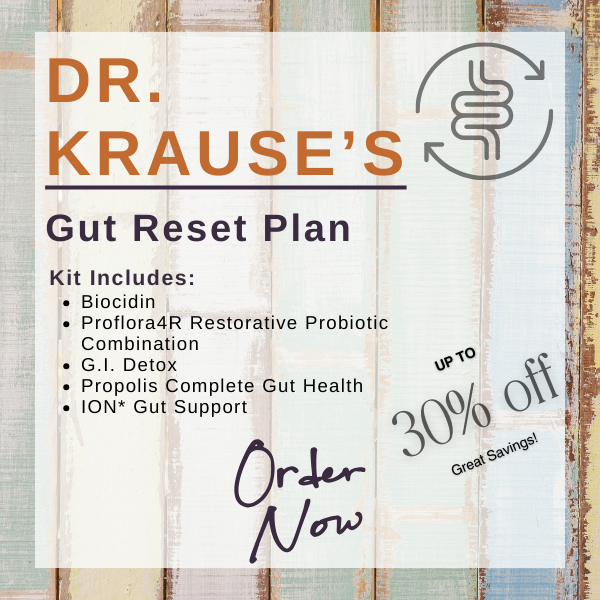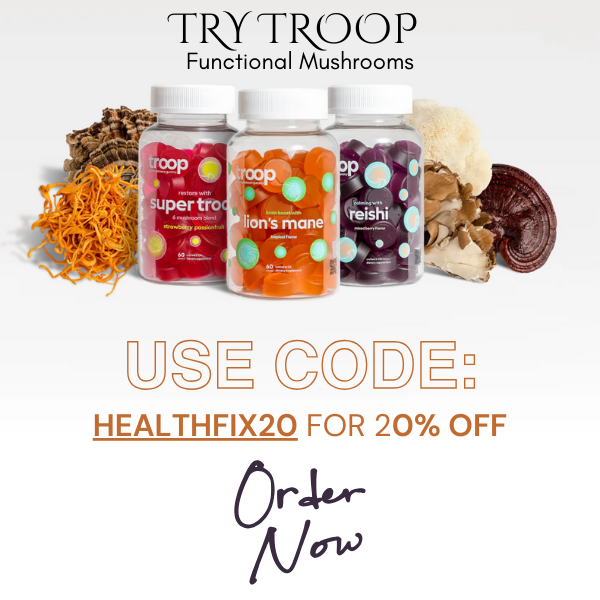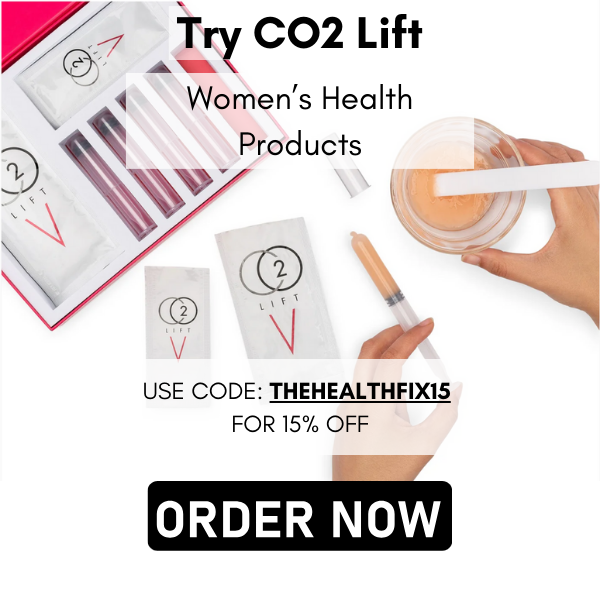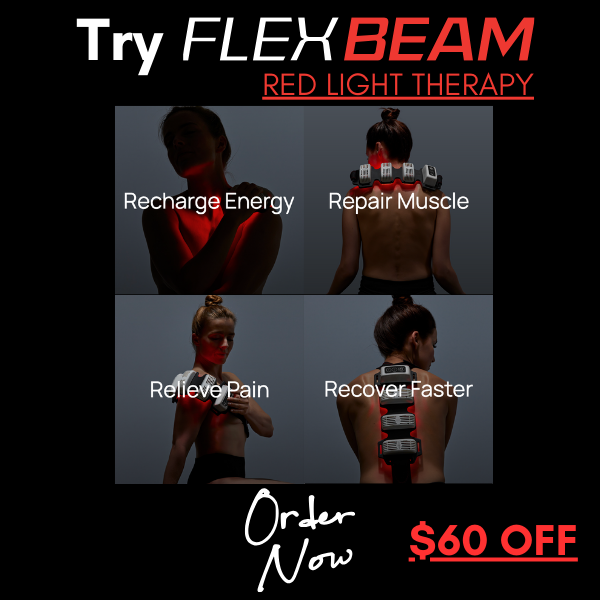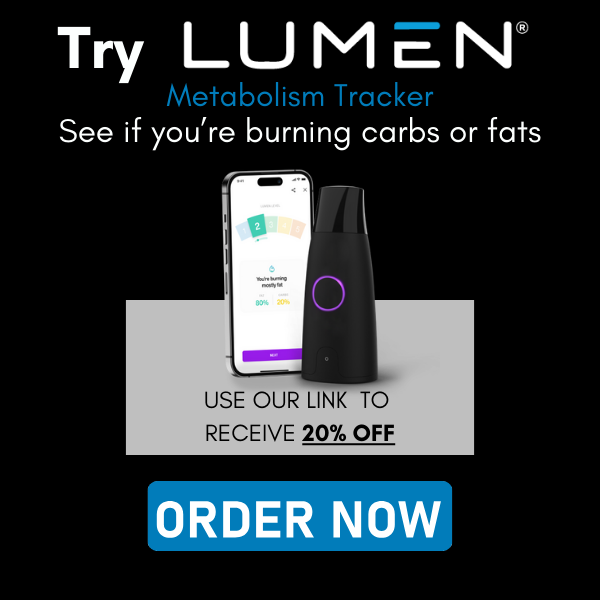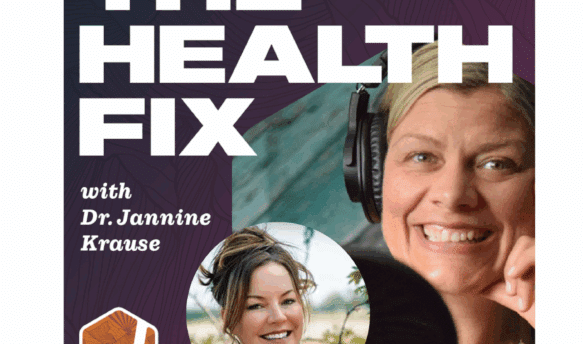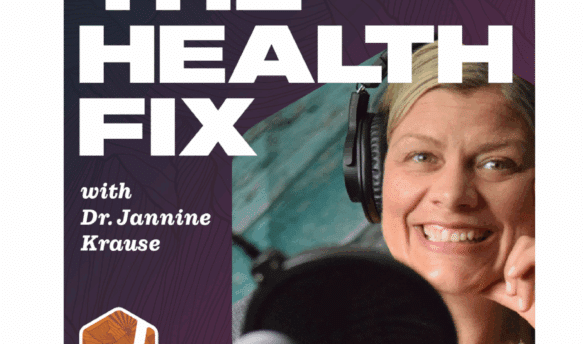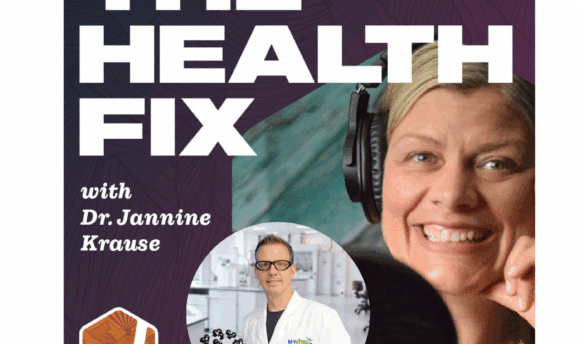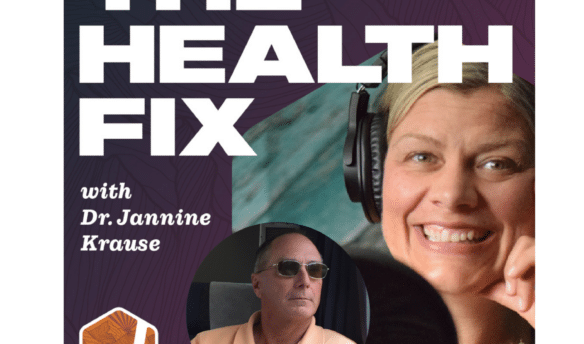Curious about how mindset, digestion, circulation, mitochondria, heart rate and HRV (Heart Rate Variability) all contribute to your longevity? Questioning what’s possible for you as you get older versus what you see in society? In this second part of a series on health optimization, Dr. Jannine Krause talks all about the impact of the mind on health and how you can improve your cell health and circulation at any age.
Dr. Krause’s Protocols
Instructions Included
Traveling soon? Looking to detox or reset your gut? Try one of Dr. Krause’s Fullscript plans.
What You’ll Learn In This Episode:
- How to restore your digestion by going back to basics
- Why your beliefs create habits, routines and behaviors that either support or degrade your health
- The basics of using your heart rate to assess your digestive, nervous and cardiovascular health
- Why mitochondrial health is just as important as gut health as you age
Resources From The Show:
- Dr. J’s PDF guide: “Steps to Become The Master of Your Health”
- Open to working with Dr. J as your guide? Bonus for podcast listeners – complimentary calls to see if & how Dr. J can guide you – click HERE
Our Partners
Podcast Transcript
JANNINE: [Intro] Welcome to the Health Fix Podcast where health junkies get their weekly fix of tips, tools and techniques to have limitless energy, sharp minds and fit physics or life. Hey health junkies, welcome to another episode of the HealthFix podcast. I’m your host Dr. Jannine Krause and today’s episode you get me again. This is part two of my thought processes basically on health longevity and just kind of giving you the tools that you can use to help set a framework as to what kind of goals you have, how to look in the future, what testing you need, what kind of metrics you need to have. I went through that in the first podcast so if you haven’t heard that one, go back to that one. So one right before this episode 413, this is episode 414. So what’s happening right now is I want folks to really be thinking about okay, I know what my health and adventure goals are. I want, I know what I want when I get older. Then the next thing is I know what I need to be tracking to have things on point. Now tracking can be tracking for the long game, so like HRV, heart rate, making sure your cardiovascular system’s on point, but it could also be tracking for the short game, trying to get those hormones balanced, making sure they stay balanced or dealing with whatever symptoms you have right now, whether it’s gas, bloating, gut stuff, constipation, you name it, fatigue, aches and pains. Those kind of metrics in the short term can be useful and then you can make long term ones too. So make sure you check out my PDFs that I have in my podcast notes at doctorjkrausend.com so that you can get a hold of all the details. Now this part, we’re going into some stuff that’s a little bit deep, a little bit philosophical. So I invite you to open your mind on some of these things. Let me give a little backstory first because we’re going to be talking about beliefs, we’re going to be talking about habits, routines, behaviors, because what gets in your way of success with your health, with finances, with anything in life is your habits, routines, behaviors in your beliefs. Now I’m from the Midwest. I’m mine as well have been from Missouri, the show me state because I am the gal that you got to show me things for me to believe it. I’ve got to test things out. I got to, you know, basically do everything I possibly can to see that something works or see that something is valid. And so when I learned that my beliefs were jacking with me, I had to think about it because the beliefs are something you can’t see, right? There are thoughts that you repeat over and over again and then you believe them. We all have them. We’ve all kind of been, for lack of a better term, I use this all the time and folks kind of cringe when I do it, especially my different folks that work with me on my mindset and behavior. I will say I was brainwashed. And the truth is, like we’ve all been brainwashed to a certain point by our family, our parents, media, whatever it may be. But when it comes to aging, we have some serious beliefs. We all do because we, what we visualize, we see what happens. You’ve seen your grandma get older, you’ve seen your grandpa get older, maybe, if you’re lucky enough to have them alive. I only had my grandma, so to be honest I only had my grandma. But mom, dad, you know, how did they age? Or how are they aging? How are your aunts and uncles? How do you see people aging on TV? In my last podcast, I talked about what we see on TV, what we see on social media. There are so many commercials about the fallen and can’t get up situation, the hover rounds. I mean, you name it. We see all that. I don’t think anyone sees those and is like, oh, I really want one of those or I really need one of those. Probably the same reason for why my father has not pulled the trigger on actually using the hearing aids that people have given him. We don’t want to believe that we need the old people stuff. But at the same time, we don’t want to believe we need it, but we see it and we go, oh, that’s what getting older is like. What if you could change your belief on what getting older has to be? What if you could change your belief on what your health has to be? Let me give you another example. So many women come to my office and go, I’m going to get fat as I get older. I need to prevent that. I’m already getting fat. I can’t lose weight. My metabolism’s been slow my whole life. I even said these things for years and years and years. And guess what? Is it true? Do we know that this is 100% true? Well, now you might be able to argue with me and say, well, doc, you know, I’ve really been heavy my whole life or how I’ve struggled with the 10, 20 pounds. And it’s been hard to get off all these years. Yeah. Okay. But here’s the thing. Did that belief come from someone else that it’s hard to lose weight as you get older? I hear all the time people saying that and I heard my mom, I watched my mom go through diet after diet after diet and guess who did them with her starting at like seven or eight years old. So this stuff is ingrained in us and it’s thoughts we believe over and over and our thoughts we think over and over again are our beliefs. So what I’d like you to do right now is to take a little trip down memory lane and let’s look at those beliefs. As they are related to your health, as they’re related to even just how you see longevity in general. What do you imagine for yourself based on your current beliefs right now? What are you worried about? What did you see happen to mom, dad, grandma, aunt, uncle? Would you see on TV? What are you like? Oh, I really don’t want this to happen. I want you to make a list of that. I want you to write down all the things that you believe about getting older. And then we’re going to go through them one by one, not in the course of this. You’re going to do that on your own. But I want you to go through them one by one and go, how do I know these are true? You haven’t went forward and came back. I mean, time travel, that’s possibility, but a lot of us haven’t got that skill yet. Now you might be thinking I’m batty, but here’s the thing. There’s a lot that we don’t know about that we can do. We’re powerful individuals. And we’re only at the brink of really being able to understand this. But if we believe it, that’s the kicker. So thoughts that you think over and over again have become your beliefs and chances are you’ve got a lot of them that are related to your health and longevity that aren’t necessarily true. So what do you want to believe is the next question. What do you want to believe about your health? What do you want to believe about your longevity? And that stems back to the question of what are your adventure and health goals? What do you want to have? What do you want to be like when you get older and what do you want to believe? I’m believing I’m going past 120. That’s what I’m believing. And I’m going to stick with that in my head. I’m not even going to put a full number on it because I don’t want to get that as my predicted answer, right? So here’s a point. Make your list of your beliefs. Make them make it nice and just spend like 10 minutes right them all down. And you’re going to see what you may be stuck with in your head in terms of those thoughts that repeat. For many women, it’s I’m going to gain weight as I look as I get older. I’m going to get more cellulite. I’m going to get weaker. I’m going to lose my ability to do X, Y and Z. We want to be stuck with those limiting beliefs. Heck no. So let’s write them down. Let’s be aware of them and go. All right. How can I change each and every one of these? Now if you’re like me and you should have been from or maybe you are from Missouri, the show me state, this is where you’ve got to make those designations in terms of how you’re going to help yourself change those thoughts to beliefs to reality. Because you’re in control of it. You’re in control of how you think. No one can take that away from you. There’s a lot that in terms of freedoms that can be taken away, but that one cannot. Only you have control of here. So write that list down and go, okay, what can I do with every single one of those beliefs to change it? Then after we’ve got those beliefs put down, what kind of habits do we need to form to change those beliefs? Because as I mentioned before, your habits, routines, behaviors, beliefs are all at play when it comes to achieving health goals. The people that get the most success in working with me in terms of weight loss in terms of being able to get stronger, faster, you know, go from couch to running Spartan races. These are the folks that look at their beliefs and go, why do I believe that? I don’t know. It’s stupid, right? And I’m not calling anyone stupid. It’s just thoughts that we have in our head that don’t serve us. So how can we change them? Linking them to that and looking at habits, routines, behaviors that go along with these thoughts. So for example, one of the most common ones, I can’t lose weight or my metabolism has just always been slow. I look at a cookie and I gain five pounds. This is what I used to say all the time, all the time. Well, of course I never could lose that 10, 15 pounds that I just kind of dragged around because I believe that. I also believe that as my mom struggled with weight as she got older and how she always struggled with weight that I was going to have that. So that was my belief. Now what happened with behaviors and habits? Well, then I would just eat, you know, when I was stressed because I was like, “Nah, who cares? Whatever. I’m just going to eat my emotions.” And then I would also overeat and I wouldn’t plan meals out. And I’d also completely sabotage myself because I would be like, “F” it, it’s just me, it’s just going to happen, I don’t care. Is that you? Maybe.” Now, I’m talking about food. Let’s go into aches, pains. A lot of us believe that as we get older, we’re going to have aches and pains that’s normal. Okay, so maybe it is, but does it mean you can’t do anything about it? Are you going to be hunched over and walk in super slow and need your cane or wheelchair, whatever. Heck no, you don’t have to go that route. What habits, routines, behaviors right now are keeping you in pain. Are you doing your mobility work? Are you doing your balance work? Are you doing your agility work? If you’re not, you’re skipping it. Well, of course, you’re going to have more aches and pains. You got to do these things. You do need maintenance. So these are the things you want to put together for yourself. Look at those beliefs. Then go back and go. Habits, routines, behaviors. That is led all around and tied in with your beliefs. Do that and you will get some really amazing answers and some tools as to what to do next. What is this? You’re creating your own protocol to move forward for your health and longevity. Game-changing stuff. Check out my PDF. That way you can see all the details that I’ve just mentioned and you can lay it out a lot better. So if you go over to doctorjkrausend.com, of course, I’m going to have that PDF right there for you and this will help you create your protocols. You don’t have to be a doctor. You can be your own stinking doctor. And this day and age, I obviously am putting this information out because I want folks to learn to be their own best doctors because following someone else’s protocols and guru this and guru that and do this diet because it’s amazing and do that kind of… No, figure out what your body needs and wants. We all have different beliefs. We all have different habits, routines, behaviors tied to those beliefs. So let’s work together and figure it out. Now some of you might be listening to this and going like, “Oh my gosh, this is so much work.” It really isn’t. If your end game is not being in assisted living, being in a nursing home, you know, in and out hospitals, think about all the money you can save by getting to know yourself. Think about how a course on, like literally you, which hopefully is your favorite subject because I would imagine most people’s favorite subject is themselves, a course on you and you alone learning how to nerd out and optimize your health, game changer. I know this isn’t for everybody, but what I do know is putting in the effort to create your own protocols for yourself, game changer. Having a doctor, somebody like a health coach, trainer, that can see the information that you’ve compiled and we’ll look at it and help guide you also incredibly huge, incredibly huge. Having a partner in your health, that can be an outside person to kind of look in and go, “Okay, cool, you’ve got all this data. Great. Let’s help you optimize it and see maybe where there’s blind spots.” Because yes, you can be your own best doctor, but having someone to just kind of check things and be like your checks and balances so huge. That’s where I’m working with folks. That’s where a lot of practitioners are going in this department. That’s why functional medicine truly exists is to help you become your own best doctor and health guru. So, for me, if folks are called to work with me great, but if they’re not, that’s fine with me too. I want everyone to know the more info you bring to the table to a doc like myself who will look at it, pour over it and geek out on it, the better you’re going to have in terms of results with gaining what you want as you get older, and staying healthy fit, et cetera, reaching your goals, whatever we’re looking at for you individually. Because let’s put it this way. There’s a lot of different programs out there like, “Get your gut on point. Get rid of SIBO.” Then there’s the leaky gut protocols. There’s the protocols for hormones, et cetera. But, that’s only one piece of you. That’s one piece of you. There’s so much more to you. All right. So, we’ve talked about habits, beliefs. We’ve talked about behaviors, routines, and how you tie those all in. The next thing in this case that I work with folks on is circulation. Circulation and mitochondria. The circulation and mitochondria, what the heck is this, why do they tie in? Well, you need good circulation to your cells. For them to make energy, for them to detox, for them to carry out cell signaling immune functions, things of that nature. Really, your metabolism is tied up in your mitochondria. But so is your longevity, so is your overall health. Because every single one of your cells, minus your red blood cells, has these little factories called mitochondria. Midochondria can get sick. They can age. They can die off. In fact, when you are building muscle and getting stronger, you will have more mitochondria because your body’s been primed to think, “Okay, if she or he is putting more stress on that particular muscle, then I need to be able to be more functionally active. I need more mitochondria.” You can create more mitochondria in your muscles as you get older. Till the day you die, it’s freaking cool. No one talks about this. No, we want to talk about on TV how you can go get your I’ve fallen and I can’t get up button. Are you kidding me? No, let’s talk about how we can empower people. Let’s talk about how we can get to energy going. So mitochondria, a big deal. We want them healthy. You can test them. I talked about in part one of my podcast about the organic acids testing. That tells us how functional your mitochondria are and how healthy they are. That’s a big deal. We want healthy mitochondria. If I haven’t said that 4,000 times, well, now you know. All right. So what we need, though, is we can have as healthy of freaking mitochondria as possible, but if we don’t have good circulation, we have problems. Same thing goes as if we have healthy mitochondria and they can detox, okay? If we don’t have good circulation of lymph and blood, now all those toxins just sit there in your lymph and that’s why we get puffy. So working on cell health, working on mitochondria, working on circulation is the next step in optimizing your health and making sure that this is part of your daily routine. On the most simple level, movement. Movement’s key. Less sedentary you are. Better things are going to go. Probably a lot of people who are listening to this right now are rolling their eyes and be like, yep, got that cover. Doc Big Check. Great. High five. Now, in addition to movement, you want to be making sure you’re doing some things that are going to help lymph movement. I have a lot of folks who are runners, a lot of folks who are bikers, a lot of folks who do crossfit, but still are puffy. What gives? We got a challenged lymph a little bit. If you’ve seen me on social media, you’ve seen anything in terms of my talks about lymphatics, usually you’re going to see me hanging upside down. I like being a vampire. I won’t stay upside down all night. Don’t want to do that more than a couple minutes. But there is something to going upside down in terms of helping with challenging your body in terms of circulation and flow. Now, if you have blood pressure issues, we got to get your blood pressure under control first. Guess what? I’m going to talk about that next in terms of training for getting your heart started, get your blood pressure in check. But circulation, mitochondria, hanging upside down, or even just laying down with legs up the wall. This can help. So thinking about ways that we can enhance your lymphatic circulation, one of the other really cool ones is bouncing. So, there are vibration plates, there are rebounders, there’s trampolines, you can get out with the grand kids or the kids or be a kid yourself and jump on a trampoline. That helps with the motion of your lymph. You could just actually do plyometric work too. Jumping work is actually a great explosive routine to do in between lifting. You want to get your heart rate up more, you want to get a harder workout and you want to see what you can do in terms of explosive power, jumping is great, skipping another way to get your circulation going, but also get that lymph moving. So that’s some of the tips. I have more in my PDF that you guys can check out. Now, here’s the other thing. How do we move circulation? There are some herbs that can help this, but there are also ways to challenge your circulation. Most people on earth have heard of Wim Hof. He has great breathing techniques, that’s one option. If that resonates with you. Another thing is doing something called contrast hydrotherapy. Three minutes hot, 30 seconds cold. You can do that to certain areas that you’ve noticed that might not be optimized as well. So your hands may be their cold, 30 seconds cold, you could do hot baths, cotton cold baths. You could do that with your feet. You could do that with sauna and you could do that with cold packs too. There’s lots of different ways to go about this. You can get super creative. Redlight therapy is a great way to bring in and move circulation in the body. I love it for the mitochondria and cells. So in addition to optimizing circulation with just physical techniques, like I mentioned, the other type of physical technique you can think of too, by the way, which I want to make sure I mention this is self massage compression therapy. So there are some types of tools out there right now that work on compressing. And releasing your blood vessels to help move circulation. You can have them on while you’re working out, but you can also use things like body tempering. You can foam roll. You can gouache. You can cup. There are so many body techniques that are out there in addition to acupressure and things of that nature. Body work helps promote circulation, hands down. And so in my PDF, I will note things, but I also can educate on different types of these. You can go on YouTube and find tons of different ways to do this. But the bottom line is there are so many techniques that you can do to enhance circulation right now that I want you to think about and I want you to try them out. See what resonates with you. For me, I love body tempering. It’s weighted tools to the body where we massage. I pair it with foam rolling and I love my Chirp, which is a wheel that I can roll and get my back to adjust itself. Another big thing is doing movements for all of your joints every single morning from head to toe. Get the wrists going, get the fingers going, get your head going, turning. Rotation is key rotation of the thoracic spine. Doing a little bit of the teapot motion left to right with the spine. Getting your hips moving, ankles, knees. Just a little two minute. Move everything. Move the joints. Huge for your circulation. Now when it comes to mitochondria, how can we amplify what’s going on in the mitochondria after we’ve promoted circulation everywhere? Well, one of the biggest ways to go about mitochondria is making sure that you have your fat, protein, and carbs going in, you’re chewing your food, you’re optimizing your digestion. And then we’re also helping with knowing where you’re at in terms of vitamins, minerals, nutrients that aren’t getting into the system. That’s where that organic acids test comes in for your mitochondria. Optimizing your microbiome helps too. But the big key here is how are your cells? As you get older, your cells will decline in getting efficient amounts of B vitamins. I use liposomal B vitamins under my tongue to help get them through the system. Of course, you want to test not guess, so back to the oat test, you could also use micronutrient testing from Spectrocell, which looks at your white blood cells as a whole, to know what’s going on in terms of vitamin, mineral, and antioxidant deficiencies. For your mitochondria, they love antioxidants. Love them. So, what’s that? Vegetables. Fruit. Don’t like those. There are greens, powders like SOS and nutrients out there that has like every single superfood and he is dialed in in terms of purity there. Or you can eat the foods, get the fiber in. Absolutely key to get in your antioxidants. I do think that liposomal delivery is key for the body and your mitochondria. I also think that looking into certain boosters like NAD, that’s something that we use the precursor of making energy, gluteethnione, which is your liver’s natural janitor. It’s made in the liver. It is our cleanup tool. Looking at your B12 and folate health status because B12 and folate are key in detoxing, so something called methylation. Huge, huge, huge. If you’ve done DNA testing, that’s also a game changer. I don’t see it as a like 100% requirement, but it definitely if you’re wanting to geek out to the max and know what might be interfering with your nutrient absorptions and things of that nature, definitely look at some DNA testing. And then with the mitochondria, the biggest, biggest thing. I saved it for the best for last of course, is your ions. How do your cells talk to each other? They use sodium, potassium, chloride. You have voltage gated channels. For me to move my arms right now, I am literally using sodium and potassium and depolarization with calcium. I could geek out for hours on how all of these little tiny electrolytes, ions are charged, help us to keep our cell circulation going and help keep our mitochondria healthy. So what am I getting at? Electrolytes. You want to be on point with your electrolytes. So many people drink too much water and dilute themselves. You want to know your body weight. How much do you weigh? Take your body weight. Cut it in half. Half your body weight announces that’s really what you need. Four liquids. Water in particular on a daily basis. If you’re exercising, maybe you need 20 ounces or so more. But folks carrying around gallons and gallons of water, you might be diluting your electrolytes and wondering why am I puffy? Well, it’s because your signaling is off because your fluid, the extracellular fluid gets off. And the cells in the extracellular space, if your ions are off. Now how do we also build up our ionic charge? Get outside, walking in barefoot. Any connection with the earth will help you. That might sound woo-woo. But you are an ionic being. So having minerals and electrolytes on point in the body, game changer for health, game changer. That’s why OAT tests can tell you where you’re at, but you could also consider taking a liposomal type of form of minerals. There’s a company called Upgraded Formulas. I’ll put their notes in doctorjkrausend.com or in the PDF. You can check it out there. But the point with this is to have mitochondria that are healthy. You want to be doing something with the electrolytes daily. There’s even I even use my own health, but my own electrolyte mix. You can put that in my PDF as well. Now also electrolytes that have minerals. There are some out there. I’ve got resources in my PDF for you as well. So there’s a lot to think about when it comes to circulation in mitochondria, but rest assured, you can do it one step at a time. Test don’t gas. OAT tests, I like the one it’s called Metabolomics from Genova, but you can also use other various forms of OAT test. There’s the mosaic company. They used to be called Great Plains Labs. They have a great OAT test as well, or you can use the micronutrient test by Spectracell. All three of those will give you the information you need to know what’s up with your mitochondria and what you want to do to keep those buggers healthy. But you can’t optimize the mitochondria on their own without circulation. So you want to be thinking about where in your body do you feel cold, where do you feel stuck? What organs might need some TLC? Use those areas and do some hot cold therapy, do some self-massage, work on things like foam rollers, work on things like guascha, different types of fascial therapy work as well. There’s a fella out there. Humangarage is his website. Amazing stuff for getting the fascial working in the lymphatic system. Check these folks out. I’ve got the resources in my PDFs.
One of the most important topics that I want to discuss as relates to longevity, health, etc. is your gut health. As you get older, your gut has had more times on this earth. It’s been exposed to more toxins. It’s been exposed to more junk and it’s been beat up more. Why has it been beat up more? Well, let’s put it this way. You overeat sometimes. You stress eat sometimes. You eat fast. You eat on the go. These things kind of beat up on your gut. So one of the most important things. And maybe one of the metrics if you struggle with gut health because unfortunately when I dive deeper on most folks, they will say that they get gas, they get bloating, some things are off. And maybe they’ve done different gut protocols and one on kill RAM pages because they thought they had SIBO or CFO and nothing really changed. The reason gut health doesn’t change profoundly when we go on different protocols is because we’re not changing the habits, routines, behaviors around the gut. You can take as many herbs or antibiotics or antifungals as you like, but if you don’t change your habits around how you eat, nothing’s going to change. We live in a very fast-paced environment. Life goes by fast. Sometimes food is a second thought. Sometimes your just wolfin’ down stuff without even thinking about it. The average American I learned once was like seven minutes on a meal. Seven minutes? Oh my god. I’ll be honest, I probably would say that I’ve fallen into this category more often than I cared to because of my job. As a doc, sometimes I’d run late with patients because of course that’s my priority. And then it would be, “Oh shoot, I have two minutes to get food in.” And a lot of times I even actually had no joke. I went through a period of my life where I only drank smoothies at work because I couldn’t chew. That’s sad. That’s really sad. And I was only hurting myself by doing that. So here’s the thing. In the realm of gut health, what happens naturally as a body ages is that we make less digestive enzymes. We make less stomach acid. So we’ll tend towards acid reflux and think that it’s more acid. More often than not, it is not that you have too much acid. It’s that you don’t have enough. And the good news is, is there is a test that costs about $22 or so depending on the going price of Betaine hydrochloric acid. Sounds scary, Betaine hydrochloric acid comes from beats. Don’t panic. There is a test called the HCL challenge. In a meal with over 10 grams of protein, you take one capsule, then the next meal you take two if you don’t get a burn and you keep going that way until you get in my world, I stop at five. The traditional folks will go up as many as it takes to get a burn in the stomach. You could end up if you’re really deficient in hydrochloric acid with like 10, 20, I mean, this is insane. A lot of pills. I stop at five because at that point, we’ve realized if you need five pills to digest your meal and you don’t even get a burn, you have low stomach acid. If you wanted a more about this, I will have the details in the PDF for you on how to do an HCL challenge. But here’s the thing. That’s only one of our problems. We start digestion as soon as we see food. We start thinking about food. We produce saliva in the mouth. As we get older, a lot of folks start to decline on saliva production. Why is that? A couple different things happen. Sometimes it’s just needing some circulation in the jaw, getting these glands here, the parodids moving so that they can release some saliva. The ones down here, sub-mental area, we’re locked up down here. A lot of people have headaches here just because it’s tight because we’re looking at computers, we’re driving, doing this and tired, or we’re just tight because we’re nervous and upset and life is stressful. So just doing some massage here can make a world of wonders in helping with your digestive system. So making sure you have enough saliva. There are conditions, sjogrens, things of that nature, autoimmune conditions, thyroid conditions where there’s less saliva production. How do we get around that? Well, lemon. Not so great for your enamel on your teeth, but lemon and lime in those kind of citrus things can help produce a little more saliva. The vinegar can do it too. That’s why part of the reason why the apple cider vinegar is in all that are super popular for meals. So we get saliva produced here. Now we get better signaling to your stomach because that saliva going down gets to your stomach and your stomach goes, “Oh, food might be coming. I should produce some stomach acid.” And then we produce other things that help with digestion to produce pancreatic enzymes from the pancreas. As we get older, another issue is having pancreatitis and issues with the old pancreas. Issues with the gallbladder. I don’t know what the latest stats are on how many adults still have their gallbladder, but boy, I hope folks still do. What’s going on there? Gallbladder flow. Help with bile. All the signaling to break down fat, right? The gallbladder is all about breaking down fat for you. That’s what bile does. It helps you to break down fat. So if we have a bile flow issue, and you can know if you have a bile flow issue, if you’re chronically constipated or chronically having diarrhea, either way, there can be a bile flow issue. How do you help it? Eating slower. Taking your time, creating each meal as an event, as a nice, relaxing event, sitting down and doing nothing but just eating, not watching TV, not scrolling on your phone. You could talk with other people. Not guzzling liquids. Either. That is another big, huge, huge thing. If you notice if you go to Asian restaurants, they have little tiny teacups. The American looks at and goes, “Where’s my big mug?” Little tiny teacups. Because you’re sipping. Part of my schooling as a acupuncturist, we talked to a ton about digestion. We talked a lot about sipping warm things to prime your digestive system. We talked about how raw cold things are really hard on your gut. What is the number one thing that most people do when they’re trying to get healthy? Eat raw vegetables. One of the hardest things for us to digest. Where am I getting at here? To help your body with longevity, you want to be thinking about what you digest well, but also what you have time for and what you want to sit down and relax for. So many people, I watch eat salads as fast as they can and you can’t really eat a salad fast, especially if you get kale or something like that in it. It takes time, you have to chew. Unfortunately, a lot of folks will eat something cold like that with cold ice water. Or sometimes they’ll see salads and smoothies. Double ice to the gut. So point being here is, what can you do to help optimize your digestion? Plan out your meal so that you’re sitting down taking at least a half hour to get that meal in and then give yourself at least five to ten minutes on the back and to help digest it. Where you’re not going to run off to go do something else and stress your body. Your vagus nerve, which is your fight or flight nerve, is in charge of rest and digest. Just as much as it’s in charge of stress mode. And so if you go from rest and digest mode and then rush right into something stressful, you’re not going to digest your food and get the nutrients from it. That’s hard on your gut. It creates leaky gut. It creates problems. This is why folks who be eating as clean as possible and they still have gut issues or still have nutrients or option issues. This is also why in thyroid conditions, nine times out of ten, most of the issue is because the gut is not absorbing iron, saline, magnesium, minerals and ions that we need to help support the thyroid. So to be able to support our mitochondria, like I mentioned before, we need ions, we need minerals, we need nutrients. How do we do this? Take time to sit down, eat and chill. And before you start eating and shoveling it all in, sit there for a minute. Let the body realize like, okay, we’re transitioning into chill mode. This is huge, huge, huge stuff here. So I want each and every one of you to be thinking about the importance of the digestive system in terms of longevity and health. And not necessarily thinking about, oh, I need to go on bug kills and this and that. Your body will actually take care of a lot of the microbiome and balance it if you have enough stomach acid production. You could do the HCL challenge and see how things go for you. You can take betaine hydrochloric for a little bit. If things get burning, over time, guess what? That’s positive. That means you’re improving. Most people that I give hydrochloric acid to are digestive enzymes too. And when I say digestive enzymes, I’m talking about the pancreatic enzymes. These are the things to break down fat protein carbs. When I give those to folks. I intend for them to not be on them for life. I intend for them to improve and not need them. They start telling me, “Doc, I’m getting a little burn with my food and get a little acid reflex. Okay, stop taking the enzymes. How’s it going?” “Great. We’ve improved things.” So you can prime your system to improve as long as you’re sitting down and taking the time for digestion. Absolutely crucial. One of the number one things that you want to be thinking about when it comes to longevity is carving out times for your meals, looking at when you feel best to eat. I don’t think everyone needs breakfast. I think some people are good with two meals a day. It’s really individual and learning yourself. Do we need time in between meals? Yes. I do think the mitochondria need time to catch up with all the nutrients because one of the other things that we beat up on the mitochondria as much as the gut is we eat too frequently and too much. There’s a huge thing in the blue zones, videos and things of that nature about how to stop eating at 80% full. This is something us Americans have a really hard time with it, but it’s really something to look into. Train yourself to eat less food. You don’t need as much as you’ve been brainwashed to believe. Another belief. Go back to your beliefs video for a second on that one.
So, digestion. Take time, plan out your meals, chew your meals, rest a little bit before you’re starting, rest a little bit after eating. Go on with your day, take time and a few. Each meal. That time in between is up to you individually, but I do recommend at least four to five hours between meals to let the mitochondria catch up and not overload them.
One of the most important things to also be on top of is your heart and your cardiovascular capabilities. The best metric to look at here is your heart rate, just knowing your heart rate. Now you can take your pulse and know your heart rate or you can have an Apple watch or I use something called a Morpheus. There’s also a Whoop and probably by the time this comes out, I will also have the Whoop as part of my menagerie of things that I use to look at heart rate and heart rate variability. But heart rate is a place you want to start. You want to spend a week taking your heart rate before you get out of bed. And you want to do that because you want to know what is your resting heart rate. This is a great metric to know is your cardiovascular system getting healthier or are you having issues? The other big thing is you can see if your heart rate goes up from your normal, you can tell if you’ve recovered from a workout or from a night of being out on the town and having a couple drinks and having some food out might be a problem. Your heart rate will also go up if you consistently have a food that you’re eating that’s bugging you or if you have a lot of mental stress and things going on in that department too. So these are really easy, free. You can do it yourself with a second hand watch or if you do have an apple watch or fit better, any of these things that take your heart rate, this can help you to understand cardiovascular where you at. Of course your blood pressure is key there too, but we can use the heart rate to help you train working out in certain zones. We can help challenge you in certain situations, things of that nature. And depending where you are in your cycle, so say you’re a woman you’ve got, your period still, there are certain times of the month when you want to challenge your heart more and other times you want to chill. For example, ovulation is the time to do sprint work. It’s the time to do the harder things like schedule the big hikes you want to do, schedule the challenging marathons and things. And then as you head towards your period, the second half of your cycle, the ludio phase, this is when you want to do more of the chill, like 120, 140 zones, not pushing too much in the 160 plus zones of heart rate. First part of your cycle, this is where you can push a little bit more. Granted while you are on the period, that is when you want to keep reserves going, but once you get in that between between the period and ovulation, you can go to more than 140, 150 higher zones and challenge yourself a little bit. Now no period or you’re a guy, you can challenge all over the place and then see how you do and use your heart rate to see if you’ve recovered. Now heart rate variability, how does that come into play? This is over time. You want to look at your heart rate variability because if you look at it every day, it gets confusing. You want to look at the trajectory over the course of a week or month and I recommend month and you want it to be improving each month as you move forward. Now how do you optimize your heart? Well, a couple different things. There’s always heart foods, antioxidants, things that are purple, things that are blue, things that are red in color. That’s going to help your heart. Now beats, blueberries, you get the idea. Now with training for your heart, what you want to know is, okay, how can I challenge myself in a sustainable manner? One of the companies, Orange Theory, that has multiple locations all over at least the west coast that I know of, that is a great place to see how it’s done except the problem is as they push people, I think, a little too hard depending on recovery stats and things of that nature. So you can do this yourself. You don’t have to go into an Orange Theory. The idea is looking at what are you doing across the course of a week in terms of your workouts? And could you put in, say on the day it’s your most rested, could you put in a more of a push kind of workout? Where you do get your heart rate up towards the 140, 150 zone, at least for five minutes and challenge yourself by minute each time. Then perhaps maybe, middle of the week, you could do a little speed up, slow down, type of workout. With the goal being to get your heart rate up, but then bring it back down within 60 seconds to about 10 to 15 points above your baseline. So for example, get your heart rate up to like 160 and then slow down, walk, stop if you have to, and breathe and see if your heart rate gets down to 10 to 15 points above your baseline. See how long it takes you to do that. That would be speed up, slow down training. Then there’s also kind of tempo training where you stay in the 120, 130 zone, 130, 140 zone, and that’s 20/30 minutes and you keep yourself in those ranges. I will put more details in the PDF on how to do this. Now definitely there are coaches out there who are conditioning coaches that are well trained in this. Maybe your professional trainer right now can help you in this department. There’s a lot of work with that. The other side of this is working on making sure your mobility is on point and making sure your strength is on point. Two absolute key components of why do you think most folks need a trainer just to have the basics down so that you’ve got that dialed in. Now mobility is huge, making sure every single one of your joints moves well. Talked about it in the metrics video, but that is huge in this department. Strength too. You should be improving in strength. You should track your strength over time. Other thing I mentioned too is balance as part of your fitness training. Sometimes I will do plyometrics jumping challenges to get the heart rate up and use some balance in between. Great stuff. Things to incorporate in when you’re looking at how can I maximize my fitness, but also how can I work on my cardiovascular system as a whole.
Now let’s bring everything we talked about today full circle. We talked about how to make the goals that you have and set them out and look at your adventures, so your health goals and your adventure goals and how to lay them out and decide what ones you really want to go after and how to make some metrics to go with them so that you can make sure that you’re moving in the right direction to take care of these goals. Now the next part I talked about is beliefs and how unfortunately our belief system gets in the way of our success and how we see aging and things of that nature. Now what I tied to beliefs is your habits, routines and behaviors. Now is the time to look at those habits, routines and behaviors that go along with those beliefs. Because chances are you might be someone like me who working out is not a problem. You are going to do that no matter what. That’s been ingrained in you. You love it. You feel good with it. That’s you. So that you don’t have to worry about that. But maybe you really struggle to wind down to calm your nervous system. Now this is something that you want to incorporate into a routine. I mentioned taking breaks during the day. I mentioned wind down routines, even starting the morning routines. Because the motion you have in the morning is what is going to set your energetic vibe for the day. Now can you change it? Sure, you can change it by calming yourself down, meditating, taking a nap. But this is crucial. This is crucial for you. So if you set up your morning so that you’re not like having to jolt out of bed and be running and running and going, now you can set your emotion to a good one, a good vibe. Where your emotions are is where you’re going to. Have your center of attraction in terms of energy. Now I might be talking a little woo-woo, but the thing here is like think about it. If you wake up in a good mood, usually you’re never a good day. If you wake up in a crappy mood, things start to happen. You can’t find your keys, your phone drops, and you break it. All kinds of things go off the rails. So thinking about how you can keep that energetic vibe good and set yourself up to have a good vibe. Now the same thing goes for your afternoon and the rest of your day. Getting breaks are crucial. Getting outside and just breathing. Kick your shoes off, walk in the grass. Depending on what time of the year it is, obviously we don’t want to end with frostbite. But thinking about what can you do to take little energetic breaks to recharge you throughout the day. Maybe it’s just laying down, putting your legs up and doing something called positional parasympathetic breathing. You lay down legs, go up on a chair or a couch or you can put your legs up the wall. You can hang up, say down like I like to do. Now the other thing is the evening. This is so crucial, telling your body works done. Life’s done, the stress is done. Now we’re going to relax. This helps you to sleep deeper and it helps you to get into a more chill mode and it helps you to recover. Because this is what protects your mitochondria, those little factories and all of your cells. It protects your metabolism. It protects you as a whole and helps you to not build up something called oxidative stress, which happens with stressful lives. So what are we doing in this case? We want to be looking at how can we incorporate some chill time into the day in terms of our routines. In particular, I’m talking about stress routines, but these can go a long way towards if you’re someone who stress eats, if you’re someone who overeats, if you’re someone who is struggling with aches and pains, how can you take breaks from these things? What can you do to help lower the level of intensity? Same thing goes, you could use your wind down or your chill time for eating before meals. Like I had mentioned, taking breaks, but also maybe taking a little time around the meal, maybe before it to go walk and spend a little quiet time to recharge yourself. So the idea here is habits, routines, behaviors, assess them. Look at them in connection with your beliefs. How are you self sabotaging? Be straight up honest with yourself. Write it down. I will have PDFs that will help to outline this and how to do this in more detail, but I highly recommend this step. Don’t skip it. This last but not least because it is the most important part of dialing in your health. Knowing what habits, routines, and behaviors and beliefs that serve you and which ones don’t. Be real with yourself. Write it down. Look at it often and I’d say at least once a month come back to it, see where you’re at, see what progress is. This is another one of your metrics. Do this along with everything else and you are going to find that aging doesn’t seem so bad. You’re going to feel a lot better. You’re going to rock some of those adventures and you’re going to be stronger, faster and your mental and physical performance will improve.
[Outro] (upbeat music) Hey fellow health junkie, thanks for listening in to The Health Fix Podcast. If you enjoyed tuning in please help support me to get the word out about the podcast. Subscribe, rate and review and just get that word out. Thanks for listening
